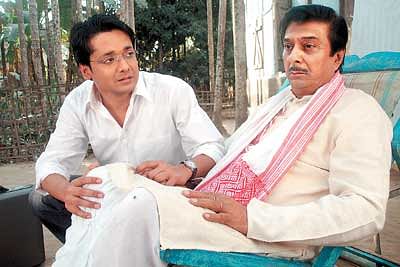Reviving the vibrancy

March 10, 1935. It was on that day that Jyotiprasad Agarwalla, a cinema-struck man from a family of settlers from Rajasthan that has contributed immensely to Assam’s cultural scene, released Joymoti, a dud at the Box Office. But that was probably the perfect way to give birth to the region’s cinema, for with its realistic treatment and a theme picked from Assam’s history, Joymoti was a film far ahead of its time, a film that laid the seed for a refined taste in filmmaking in the state in later years.
Perhaps Joymoti was destined to fail, since there were hardly any theatres in Assam in those days to screen films. But Jyotiprasad — a poet, playwright, novelist, musician and freedom fighter, known as Assam’s foremost cultural icon — had perhaps more intent in creating a film culture than just a commercial venture. Which is why he did not go ahead and just make a film. He first got himself trained in filmmaking at the UFA Studios in Germany with Franz Osten and Himanshu Rai, and then established a makeshift studio in his family-owned Bholaguri tea estate on the north bank of Brahmaputra to shoot the film.
Recently, Assam officially celebrated the Platinum Jubilee of that first step by Jyotiprasad, in other words, the 75th anniversary of cinema in not only Assam but the entire North-East India. The celebrations were low key, confined to a cultural evening coinciding with the state film awards ceremony on March 10, followed by a festival of some of the most acclaimed old and recent films at a theatre in Guwahati.
Perhaps the mood was made sombre (even if unintentionally) by the fact that in recent years Assam’s filmmakers have been facing a similar predicament as Jyotiprasad did 75 years ago. There is a dearth of theatres to screen their films. Consider this: from over 250 halls about a decade ago, hardly 50 halls exist in the entire state now, out of which about 30 are located in regions where Assamese-speaking people reside. The number would be much lesser if one considers screening space for the few films made in various ethnic languages of the state.
The people in the ‘industry’, if one may call it that, are debating ways to get the local cinema out of the rut, back to what it was in the 70s and 80s when filmmakers could hope to not only regain their investments but also make some profit to start their next venture. But the lack of commerce has been made up many times over by the national and international laurels that some of the state’s filmmakers have brought in over the years. If Piyali Phukan (1955) by Phani Sarma was the first film from Assam to earn plaudits outside, winning a Certificate of Merit in the National Film Awards of India in 1959, Puberun by Prabhat Mukherjee was the first film from Assam to be screened at an international film festival, in its case Berlin.
Dada Saheb Phalke Award winning singer-lyricist-composer Bhupen Hazarika, mentored as a child by Jyotiprasad, was one of the key contributors to Assamese cinema. He made films such as Era Bator Sur (The Tune of the Deserted Path), Pratidhwani (The Echo), Latighati and Chikmik Bijuli. It was in 1976 that Padum Barua made Ganga Chilanir Pakhi, giving Assamese cinema a new direction. Barua’s only film, the first film after Joymoti that was also realistic in its treatment, presented a story that reflected the society in rural Assam.
The next year saw the emergence of Bhabendra Nath Saikia through Sandhyarag, based on his own novel. The film drew worldwide attention to Assamese cinema. Saikia, a physics professor-playwright-director, made a mark internationally through his simply-told stories in Anirbaan, Agnisnaan, Kolahal, Sarathi, Abartan, Itihaas and Kaalsandhya.
If Saikia provided the spark, Barua fired Assamese cinema to greater heights. This FTII-trained filmmaker started off with Aparoopa and its little-known Hindi version Apeksha in 1982, and went on to highly-acclaimed films such as Papori, Banani, Pokhi, Kuhkhal and Konikar Ramdhenu. His Halodhiya Choraye Baodhan Khai (The Catastrophe) and Hkhagoroloi Bohu Door (It’s a Long Way to the Sea) won a host of top national and international awards.
Following his footsteps, a host of filmmakers emerged, tackling diverse subjects in a realistic tone, some of whom are Gautam Bora, who made the outstanding Wosobipo in the Karbi language, Sanjeev Hazarika (Haladhar and Meemanxa), Santwana Bardoloi (Adajya), Bidyut Chakraborty (Rag Birag), Bodo filmmaker Jwndao Bodosa (Alayaran, Hagramayo Jinahari) Manju Borah (Baibhav, Akashitorar Kothare, Aai Kot Nai) and Sanjib Sabhapandit (Juye Poora Xoon, Jatinga Ityadi).
Assam’s contribution to the film world beyond has also been significant, with Pramathesh Barua, a contemporary of Jyotiprasad and a scion of the royal family of Gauripur (a small erstwhile princely state in Assam,) being the most prominent. Bhupen Hazarika, who continues to stride like a colossus in the state’s cultural arena, has given some memorable music for a few Hindi films (who would forget his ‘Dil Hoom Hoom Kare’ from Rudaali), while Seema Biswas has become one of India’s most appreciated actors.